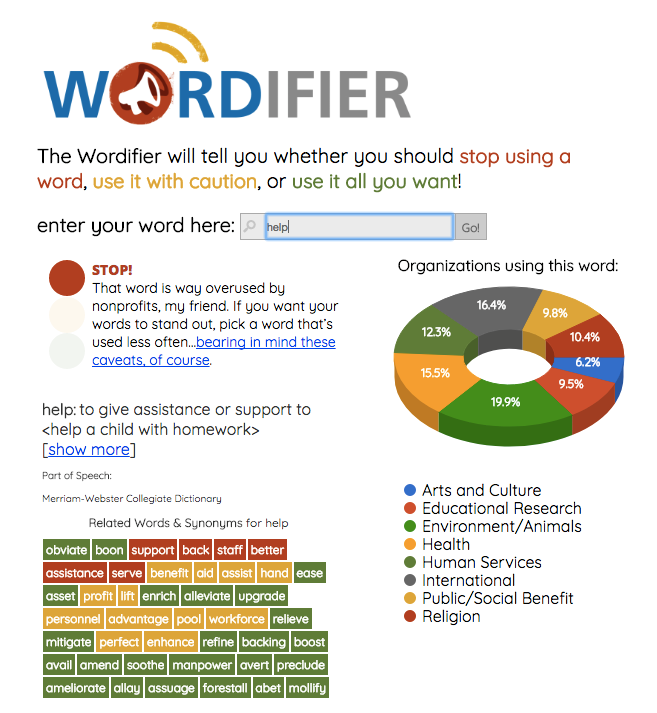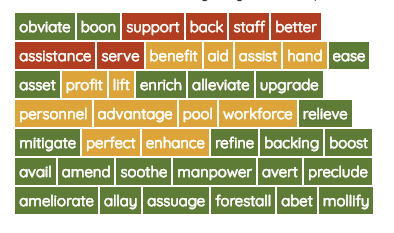I had the pleasure of chatting with Maria Ross on the Marketing for Good podcast about the three types of empathy: compassionate empathy, emotional empathy, and cognitive empathy. You can watch the 5 minute vlog about the episode below or listen to the full episode here.
Blog
Is your nonprofit using words as tactical instruments?

Not so long ago, I had the pleasure of chatting with Dana Van Nest on the Marketing for Good podcast. You can listen to it here or read it here, whichever floats your boat!
Dana knows her way around words. She writes. A lot. And really well. She works with clients on a mission to make the world a better place.
The idea of words as tactical instruments sprung forth during our conversation. (You can practically see the words springing forth in service to your mission, can’t you?!)
Writing can sometimes come across as blob-like. A bunch of words. On a page. Milling about.
But if you think about words as tactical instruments, that’s a different (and I believe more actionable) way of thinking about writing. It shifts things so you’re focusing on the power of each word to advance you toward a specific goal.
If the end game for a newsletter, annual report, website, speech, or mission statement is to move someone–a donor, volunteer, client, customer, etc–closer toward a specific goal–donating, volunteering, or being served, to name just a few–each word counts. And each one has the power to get you one step closer to that goal. And those goals advance you toward your mission and your vision for making the world more awesome.
When used as tactical instruments, words become willing and loyal pawns in the chess game of making the world a better place.
How flippin’ cool is that?!!!!
If picking each word that carefully makes your palms sweat, here’s what you do: look at the verb in the first and last sentence of whatever you’re writing. Verbs are action words. Will the verbs in those two sentences get you closer to your goal? If so, super. If not, get some word-spiration from the Wordifier.
Want to get better results from your marketing…with less stress and more joy? Get on Claxon’s list and get actionable insights, tips, and tricks delivered directly to the comfort of your inbox!
Marketing Your Nonprofit Association (when things are totally weird)
Associations rely on membership dues to pay bills. They need to market the value of those dues. Nonprofit associations are no exception.
How do nonprofit associations market their value with less stress and more joy…during a global pandemic that has them working their tails off to serve nonprofits in their states and advocate their hearts out on behalf of the sector as a whole?!
That’s what I asked Brandy Strand of Utah Nonprofits Association when I had her on the Marketing for Good podcast.
Brandy had some terrific insights (and is a pint-sized joy bomb to boot!). I paired her insights with research on trends in association marketing and here are the two things I’d recommend nonprofit associations focus on to boost their marketing efforts:
#1: Put Out Responsive, Flexible Programming
One of the most striking things about my conversation with Brandy was how in tune they are with their members’ needs. They survey them regularly and get real-time feedback in a variety of ways. This means they can adapt their programming and make members happy.
When you’re thinking about content–especially things like webinars which in the past may have often only been available if someone showed up live–think about how flexible you can make it. Record things so folks can soak it up when it fits their schedule. This will delight members in a good way…and, you guessed it…get them talking about you.
Brandy and her team are doing this, getting very positive feedback, and also building out an entire resource library that will serve their members for years to come.
Course-correcting takes effort, yes. But it’ll pay off in multiple ways as you’ll see in #2.
#2: Fuel Word-of-Mouth Marketing
Right now, we are relying more than ever on trusted peers and colleagues for advice. If your programming is responding to members’ needs, they will be delighted! It’s tough sledding these days so we’re even more likely to talk about something delightful because it’s a break from the monotony and chaos of working from home during a global pandemic.
Word-of-mouth marketing is FREE MARKETING.
Make it easy for folks to talk you up. Now’s not the time for messaging that is clever, coy, or cute. Stick to the point. If someone has to think too hard to get your point, they’ll tap out rather than tune it.
Keep your messaging straight-forward and the Calls to Action (CTAs) in your marketing as clear as possible.
Examples: For advocacy, “Call Your Representative Today”. For a webinar, “Register Now”. And, of course, make it clear that although you’d love folks to join you live, it’ll be recorded so they’ll be able to watch the webinar whenever it strikes their fancy.
(When you listen to the podcast, you’ll hear that Brandy and I had different definitions for CTAs, which is why you always have to be careful when using acronyms!)
Also, make it easy to share your content. Have links/icons to all your social media handles. Don’t make anyone forage. We’re all too tired to forage (unless it’s to the back of the freezer for some huckleberry ice cream).
By the way, these tips apply to all nonprofits right now. Just swap out donors for members in #1, follow all the advice in #2, and you’ll be ahead of the curve.
For more marketing inspiration and motivation, listen to the Marketing for Good podcast wherever you enjoy your podcasts!

#MarketingForGood Drawing

How to Enter to Win:
- Go to wherever you listen to podcasts.
- Search for Marketing for Good.
- Subscribe, rate, and review. (Trust me, it’s easy.)
- Before submitting your review, TAKE A SCREENSHOT.
- Post the screenshot on social media using the hashtag #MarketingForGood or email it to info@claxon-communication.com.
- For the next 4 weeks, we will randomly select one lucky reviewer who will receive a free 1, 2, 3 Marketing Tree or a copy of Pitchfalls.
- All reviewers will be entered into a Grand Prize Drawing to win a free Coaching Session with me. (A $425 value.)
All in, this should take you about 3 minutes, depending on how much time you take on your review. My advice: don’t overthink it. It’s a podcast review, not your annual report.🙂
THANK YOU!!!
October Word(s) of the Month: Goals vs. Objectives
 Goals. Objectives. What’s the difference? And do you need to care?
Goals. Objectives. What’s the difference? And do you need to care?
If you care about your nonprofit being successful then, yes, you need to care. You know that setting appropriate goals and objectives are key to the success of your nonprofit’s initiatives, and your nonprofit as a whole. Because you can’t save the world without a plan!
And according to the Claxon Method, if you’re not clear on your goal, you can’t identify your target audience, and then your messaging risks running amuck. And, although amuck is fun to say, it’s not strategic to do.
That’s why this month, we’re diving deeper in the meanings of goal and objective. We wanted to know: Can we glean anything useful by looking at the history and evolution of these two seemingly similar words?
Let’s start by looking at how we use these today, especially in the business world:
Goal: An overarching aspiration that guides your decisions.
Objective: The smaller, measurable steps that get you to your goal.
For example, the goal of your nonprofit organization may be to end homeless in your city. An objective may be to increase the amount of affordable housing in your city by 50% within 5 years.
Makes sense.
While these words both evolved at different times and in different ways, the definition is basically the same: A destination. Maybe that’s why people use them almost interchangeably.
But it’s worth understanding where these two words came from and, therefore, how they are distinct from one another.
It turns out goal has a longer history than its cousin objective. According to Etymology Online, it first appeared in a poem in the early 14th century as gol, indicating a boundary or limit. The interesting thing? That poem was the word’s only known appearance until a few decades later, when it started to show up as “the endpoint of a race”.
So goal has its roots in sports. Obviously, there’s still a lot of goal-talk today in sports. But when did it evolve to also mean a purpose, or something to strive for, outside of a sport?
Most likely, somewhere around 1960 when the word’s frequency in written communications began to increase drastically:
Why the increase? Dunno exactly. But there’s no denying it became in vogue to have/use/write about/talk about having goals. Cuz, #LifeGoals.
In comparison to goal, objective hasn’t been around as long. It appeared as an adjective in 1610 as the counter to subjective, meaning simply “in relation to its object”. Only much later, in 1855, did it start to indicate “unbiased and quantifiable”. (If you’ve ever put together a research study or survey, you’ll know this usage well.)
The usage we’re interested in for this post, meaning “aim or goal” came about much later. In 1881 to be exact. Objective point is a military term used to describe a place upon which to focus a troop’s attention. The stand-alone objective (minus the point) evolved from this usage.
So, whereas goal sprouted from a general boundary or endpoint in a race, objective is rooted in military strategy. Could this be why objectives are smaller and more measurable than goals? In military strategy, your overall goal may be to win a war, and its the objective points of individual troops that will get you there.
I can’t say for sure if this is the case. But I can say that being mindful of the difference between goals and objectives, and having both for your organization make you and your nonprofit more successful. And your messaging more remarkable!
Side note: According to The Wordifer, goal is one of those words that nonprofits use too darn much in their external communications. Yet, its cousin objective isn’t nearly as prevalent. If you think about it, this makes sense. When we’re communicating our nonprofit’s purpose to the world via our website, we’ll often speak of our end goals, and not the objectives that carry us there. However, if your goal is to inspire trust in your supporters — and it should be — you might way to share your objectives as well.
September Word of the Month: Reflections on Reflect
 Many of us in the nonprofit-sphere, including us here at Claxon, tend to enjoy setting aside time for reflection at the end of the year or the start of the new year.
Many of us in the nonprofit-sphere, including us here at Claxon, tend to enjoy setting aside time for reflection at the end of the year or the start of the new year.
And for good reason. Year end brings a concrete time to close out those financials, wrap up successes (and perhaps failures, too) in a pretty annual report, and figure out what you’ll do differently in the fresh start of the coming year.
We’ve been thinking about — or should I say reflecting on — the concept of reflection here at Claxon recently. And being the word nerds that we are, we decided to delve into the word itself to find out what we can learn and how we can tie it back to our professional and personal lives.
In this post, we’ll share what we’ve learned: how the definition of reflect has changed over time, how nonprofits are currently using it, and how YOU can use it now to set yourself up for a more impactful future.
The Origin of Reflect
The original definition of reflect, one that’s been around since the 14th century and that we still use today, is the bending of light back toward its source. In fact, the root word -flect simply means “bend”. (Catholics will recognize this from genuflect, which is a fancy way to say bending your knee in respect.)
This meaning of reflect can take many forms: the moon reflecting the sun’s light to Earth, the sky reflecting its color off the ocean, some random light reflecting off of my watch and onto the wall driving my cat crazy, etc.
Reflect is what happens when you look in a mirror. And it’s perhaps this use that caused reflect to move from a mere reflection of light to a reflection in the mind, in the second half of the 17th century.
Reflection definition #2: serious thought or consideration.
Today’s Usage & Nonprofit Usage
In recent times, we are putting even more emphasis on reflection, and my guess is that this is not the light reflection definition. The following graph, supplied by Google, shows the usage of the word “reflect” as a percentage in books from 1800 – 2008.
What caused the sharp bump in the latter half of the 20th century? Could we, as culture, be putting increased focus on reflection of the mind? Perhaps self-reflection in particular?
While I don’t know the answer to that question, I am able to see how nonprofits are using the word “reflect”, specifically on their websites. According to the Wordifier, nonprofits tend to use the word somewhat frequently. It earns a yellow light in the Wordifier’s scale:
While usage of reflect is pretty evenly distributed across the nonprofit sector, religious organizations tend to use it a bit more:
Are religious organizations reflecting more than other nonprofits? Or, are they encouraging their supporters to reflect on their own lives and beliefs? Either way, all nonprofits and their staff members have an opportunity to follow suit and challenge themselves to be more aware – reflecting on their endeavors throughout the year and not just at year end or during infrequent strategic planning sessions.
Resources for Reflection
Many resources exist to help you build the practice of reflection into your life and your work. You can also find specific ways to incorporate reflection into your nonprofit’s routine.
Here at Claxon, we’re all about remarkable messaging. We know that the words we use to talk about our nonprofits make a big difference in the results we see.
That’s why we have a few free tools for you to reflect on your language choices to raise more money and do more good.
Messaging Quiz: Is your messaging helping or hurting your nonprofit’s mission? Take this five-minute quiz and find out.
Organizational Lexicon: This nifty tool will help your nonprofit create your very own lexicon. By doing this you up the odds that you’ll use words that make you consistently stand out from the crowd.
Personal Lexicon: In this day and age, personal brand is important. The words you use are part of that brand. With this in mind, we adapted the Organizational Lexicon, so you could create a lexicon all your own!
What reflection practices do you have for your life, your work, and your communications strategy? Tweet to us @ClaxonMarketing and let us know!
August’s Word of the Month: HELP
Help is such a core part of our non-profit identity. So, how can we can possibly stop overusing this word? Read on to find out in our latest installment of Word of the Month.
“Help!” It’s what the non-profit sector is all about, right? We help the environment, we help children, we help the homeless. We ask folks to help us carry out our mission with support, donations, and volunteer hours.
With all this helping going on, I’m sure you’re not surprised to learn that according to our research, “help” is high on the charts of the most commonly-used word by non-profits. (Others include need, more, support, and please. Notice a trend?)
We also know that overused words don’t do anything for our mission. By using the same words that every other non-profit uses, our mission statements and other communications get lost in the abyss of overlooked messages.
This is why The Wordifier gives us the red light on the word “help”.
Nonetheless, many organizations continue to use this word, and use it heavily. Here are a few examples of mission statements I discovered by googling some well-known non-profits:
To help people worldwide where the need is greatest, delivering emergency medical aid to people affected by conflict, epidemics, disasters, or exclusion from health care. – Doctors Without Borders
To alleviate suffering, poverty and oppression by helping people build secure, productive and just communities. – Mercy Corps
To help more moms have full-term pregnancies and healthy babies. – March of Dimes
With helping being such a core part of our non-profit identity, you may wonder how we can possibly stop overusing this word and make our mission statements and other messaging more remarkable. What’s a non-profit to do?
Well, let’s start by looking back to help’s origins.
Not surprisingly, the word help dates back pretty far, stemming from the Old English helpan. At that point in time, it was exclusively a transitive verb, meaning it was required to have a direct object tied to it. For example, you couldn’t just helpan in general, you had to helpan something.
In the 13th century, this changed, and the intransitive use emerged, meaning to “offer aid or assistance”. Help moved out of the realm of an action-packed verb, and into more general, conceptual realm.
And this is my advice to non-profits: Think of help not as an action word, but as a concept. When you frame it that way, you’ll see that there are other words that will get your helping point across in a stronger way.
Luckily, The Wordifier offers alternatives to any given word that are not overused, and therefore will make your mission and messaging shine! Pay special attention to the words in green, as those are the least commonly used by non-profits. 
You’ll also notice that these words can pinpoint an exact action in a way that the generic “help” cannot. “Ease” has a much different meaning than “boost” or “amend”, yet all three can be used in place of a “help” depending on the context.
Here are a few examples of non-profits successfully replacing help with a more descriptive, yet similar word.
To defend and preserve the individual rights and liberties guaranteed by the Constitution and laws of the United States. – ACLU
To connect people through lending to alleviate poverty. – Kiva
To create, find and support programs that directly improve the health and wellbeing of children. – Ronald McDonald House.
Take a stab at removing help from your own communications, and share your results with us @ClaxonMarketing. I hope this post enriched your view of non-profit word choice, and will upgrade your non-profit’s future messaging!
Want to upgrade your non-profit’s messaging even more? Check out our online training through Claxon University.
How Pitches Transformed My Nonprofit Marketing Career
In October of 2013, I uploaded my first YouTube video ever. The subject? A short, how-to video for nonprofits to pitch their cause at networking events.
Let’s back up a sec. Before the fall of 2013, the extent of my nonprofit experience was administrative. I had a passion to do good, but didn’t quite know how to do it. I was shy, lacked confidence in my skills, and dreaded conversations with strangers (and even acquaintances!)
I had just enrolled in the course Strategic Marketing for Nonprofits at Seattle University, where I was fortunate enough to meet Erica Mills, the instructor of the course and the brains behind Claxon Marketing. In just a few classes, she turned my passion-without-direction into confidence-with-passion.
How? By stressing the importance of pitches for nonprofits, while at the same time showing that not only are the not scary; with the right amount of preparation they can be downright fun, a bit liberating, and incredibly important to your cause. (And by pushing me out of my comfort zone to make this video 🙂 ) Since then, my path as a nonprofit marketer has been set, and I’ve been perfecting pitches (and other nonprofit marketing materials) ever since.
Caption: Screenshot from my YouTube debut.
Why am I telling you all this? Because you’re about to have the same opportunity I did. On July 26, 2017 at 1 p.m. ET, Erica will take to the web to present a one-hour free webinar all about creating the perfect pithy pitches for your cause.
For a bit more background into why pitches are paramount, let me describe a generic interaction, but one you have probably experienced firsthand:
Say you’re at a networking event (or party, or fundraiser, or wherever you typically meet new people) and someone asks the inevitable question, “What do you do?”
You don’t know this person, or what their interests are. They have the potential to be your nonprofit’s next big donor, small monthly donor, or volunteer. Or even your next boss.
Will your response to their question spark their underlying interest in your cause, inviting them to ask more questions and get involved? Or will it make them pretend they need to refill their drink two minutes after your explanation of your work?
Good pitches are rare. Unless you take the time to fix them up.
In the upcoming, not-to-miss webinar, you’ll:
- Hear more examples of why pitches are so important
- Learn what a pitch really is (it’s not what you think)
- Find out why your pitch(es) are probably bad
- Get to know the five top “pitchfalls”
- Learn how to perfect your pitch, and in turn get people curious about your cause and start raising more money.
Don’t miss your chance to be transformed (like I was!).
| [btnsx id=”8129″] |
New (lower) price for Claxon U!
 The Punch Line
The Punch Line
The price for Claxon University’s on-line training–Words on a Mission–is now $425 if you pay up-front, or $40/month for 12 months.
The Rationale
We created Words on a Mission because we wanted as many non-profits, do-gooders, and mission-motivated trailblazers as possible to be able to learn how to create remarkable messaging.
We did it so communications conundrums could become a thing of the past.
We did it because we know that effective communications leads to engagement.
To more funds, and awareness, and good in the world.
That’s why we did it.
Claxon U “students” have knocked it out of the park when it comes to getting results. Totally awe-inspiring what they’ve accomplished.
We want those results for absolutely everyone. We want them for you.
But recently we had one of those moments. A moment when you realize if you’re going to achieve your vision, you need to course correct to get there.
At $949, Words on a Mission seemed fairly reasonably priced. It’s about $25,000 worth of consulting all wrapped up in a self-paced on-line training that anyone can do. Nifty.
But recently we did a webinar with Vu Le and the topic of professional development came up. We asked participants how much budget they had for professional development. We knew it wasn’t going to be much and–wowee– it is not a lot.
$949 isn’t doable, even for mid-size organizations. So we decided to do something about that.
We sat ourselves down and said, “If the goal is to get this into the hands of as many people as possible, how low can we go and not lose money?”
$425. That’s how low we can go.
So that’s the new price. $425 up front, or $40 per month for 12 months.
We had to trim down a few things to make this price doable. For instance, we’re no longer going to do on-line office hours. But you’ll still be able to ask questions via the private Facebook group, so you won’t ever be stuck and not have the support you need. We got your back.
If you’ve been on the fence about doing this training, hop off the fence and into the land of communications awesomeness! You know you’ve got it in you. We believe in you.
July Word of the Month: Remarkable
This is the latest installment in our “Word of the Month” series to help non-profits make intentional language choices (while indulging our own word nerdery). Up this month? Remarkable.
A few months ago, we explained why we love the word remarkable so darn much. So much, in fact, that we’re happy to leave “awesome” in the dust for this striking and incredible word (that basically means striking and incredible! How about that?)
We’re guessing that you think your non-profit’s cause is pretty remarkable. Yet,1 you also likely continue to use the same stock of words, such as “awesome” and “great”. We looked to the Wordifier to show us how all of these words stack up:
The word remarkable stems from the French remarquer which means, “to take note of” or “worthy of notice”. Definitely something we all wish folks would do with our cause!
Okay, so now that we know why remarkable is so remarkable, what other words fall into this category?
Again, we turned to the Wordifier to advise us. (By the way, if you aren’t familiar with the Wordifier and why it’s a remarkable tool for choosing your non-profit’s words, check out this post). And since verbs are the superheroes of our sentences, let’s start there.
Here are a few remarkable verbs that the Wordifier gives us the green light on. I’ve bolded my personal favorites 🙂
Accelerate, activate, alleviate, anchor, broaden, collaborate, complement, confront, cultivate, deepen, defend, delight, elevate, eradicate, generate, ignite, illustrate, mobilize, motivate, nurture, rally, relieve, remedy, revitalize, shield, stabilize, steward, sustain, unite, uphold.
And here are some adjectives to spruce up your sentences:
Adept, apathetic, brilliant, colossal, deafening, diligent, disillusioned, endless, fierce, gentle, hopeful, hushed, illustrious, immense, lively, nimble, remarkable, rapid, resonant, somber, splendid, striking, swift, vigorous, zealous.
As you can probably tell from reading these words, they are not your standard, run-of-the-mills “awesomes” and “greats”. Each of these words paints a picture, gives a concrete feeling, and most importantly, are not overused by non-profits.
What are your favorite remarkable words? Tweet to us @ClaxonMarketing.







